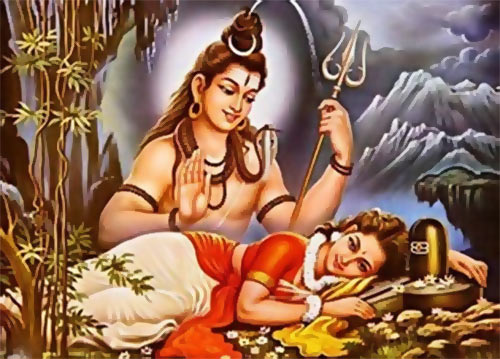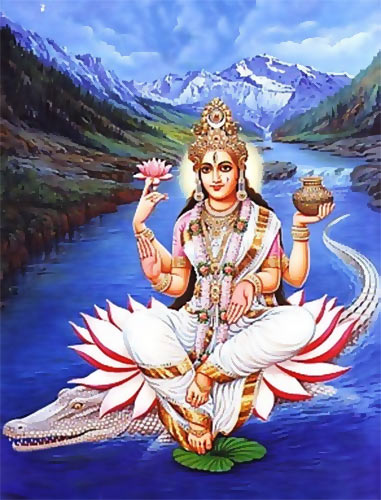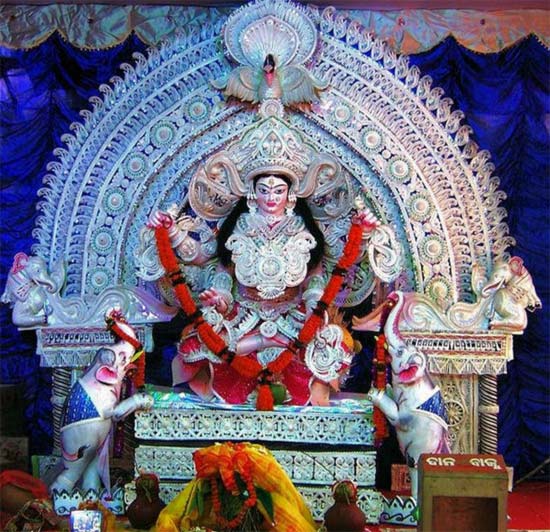Photographs: Rashkesh/Wikimedia Commons
As we celebrate Mother's Day this weekend, a look at goddesses Indians have worshipped over the centuries.
We start out with Adi Parashakti the 'source' so to say of all the other goddesses in the Hindu pantheon.
She personifies the divine feminine power in the universe and is often referred to as 'The Great Divine Mother'.
Parvati, Lord Shiva's second consort is her human embodiment.
Quite literally, Adi Parashakti means one with eternally limitless power. In it then she is the one responsible for the eternal cycle of creation and dissolution in the Universe.
Goddess Durga
Image: Goddess DurgaPhotographs: Dipankan001/Wikimedia Commons
One of the most prominent mother goddesses in the Hindu pantheon is Durga who was created to combat the demon Mahishasura.
To narrate the popular story: Misusing a boon given to him by Brahma, the creator, the demon Mahishasura had unleashed upon the heaven, earth and the nether worlds his reign of terror.
Helpless in the face of the Brahma's boon that protected Mahishasura from being killed by any man and God, the Gods went to him to seek help.
Along with Vishnu, the creator and Shiva the Supreme Destroyer and rejuvenator, the gods combined their energies. Thus was born Goddess Durga.
Since she was neither a man nor a god, there was nothing that could stop Durga from killing the evil Mahishasura.
In a pitched battle that followed, the Goddess slew Mahishasura thus ridding the world of evil and thus earning her the name Mahishasurmardini or the slayer of Mahishasura.
Kali
Photographs: Jonoikobangali/Wikimedia Commons
As with most goddesses and gods, Kali too varying stories. Among the most famous of the legends goes thus: Goddess Durga is engaged in a battle against the demon Raktabija who clones himself each time a drop of his blood drips from his body.
As the battlefield is filled with the duplicates of Raktabija, Durga summons Kali to combat this unusual demon.
According to some other versions of the legend, Goddess Durga transforms herself as Kali. Some other versions describe her as being born from Durga's forehead.
In any case Kali, wearing a tiger's skin and a garland of skull, gaping mouth and bloodshot eyes devours the Raktabija's duplicates before sucking the last drop of blood out of his body.
Sati
Born to the great king and Brahma's son Daksha Prajapati, Sati was Lord Shiva's first consort and is said to signify marital felicity and longevity.
According to legends, it was Brahma's design that she should please Shiva and marry him.
Even as she grew up adoring the legends of the great lord and decided that he would be the one she'd marry, her father abhorred the idea.
Turning down all the proposals she'd received from great and powerful kings, Sati went to Mount Kailash to serve the one she wanted to marry.
Devoting herself to serve the great Lord, she went through rigorous penances surviving on a single bilva leaf every day and eventually giving up even that.
Her prayers finally bore fruit when Shiva agreed to marry her and Sati returned to her father's home to await her groom's arrival.
Sadly, Daksha didn't approve of the match, even though the two got married eventually and Sati made Kailash her home.
Then came the day when Daksha organised a grand yagna or a fire sacrifice and invited all the gods except Shiva and Sati. Reasoning that she didn't need an invitation to her father's home, Sati went anyway.
Unsurprisingly, she was received rather coldly and a heated argument about Shiva's supposed lack of virtues followed.
On realising that the abuses being hurled at Shiva were only because she was married to him, Sati invoked the yogic agni and immolated herself.
A devastated and furious Shiva then unleashed Virabhadra and Bhadrakali (also known as Manbhadra) who destroyed the scene of the incident and killed practically everyone present there not even sparing Daksha who was decapitated.
It was on this night that Shiva is said to have performed the fearsome Tandava dance with Sati's body on his shoulders. The body came apart and fell at different places on earth.
However according a separate version, the Gods called upon the Vishnu to calm Shiva down. The creator then using his sudarshan chakra or the divine wheel dismembered Sati's lifeless body that fell in 51 places on earth that came to be known as Shakti Peethas or centres of power that are now major centres of pilgrimage.
Shiva calmed down and granted life to everyone who was slain. Even Daksha was granted life and his kingship restored. However his decapitated head was substituted for that of a goat and having learnt a lesson the hard way, Daksha spent his years as Shiva's devotee.
Parvati
Image: ParvatiPhotographs: Benjam n Preciado/Wikimedia Commons
After the death of Sati, Shiva has lost all interest in worldly affairs. However she appears in his dreams and assures him that she would return to him as the daughter of Himavat.
Meanwhile Himavat, the great king of the Himalayas and Mena are performing sever penances to appease the goddess Adi Shakti who agrees to be born as their daughter.
Much like Sati, Parvati too grows up being interested in the tales of Shiva and even remembers her previous life as Sati. Growing up to be a woman, Parvati begins penances to appease Shiva to grant her wish to reunite with him.
Touched by her devotion, Shiva agrees to marry her and Parvati moves to Mount Kailash.
By drawing Shiva out into the worldly affairs, Parvati became the symbol of virtues such as fertility, devotion to the spouse and power among others that are held in importance in the Hindu culture.
Ganga
Image: GangaPlaying a significantly small role in the unfolding of the narrative of the Mahabharata, Ganga is also perhaps the most interesting of its characters.
Cursed by the sage Vashishta, the Vasus or the attendant deities of Indra and Vishnu, request Ganga to be their mother. When she is incarnated, Ganga marries the great King Santanu on the sole condition that he would never once question anything she does and the day he would, she'd leave him forever.
She begets seven children from Santanu who are in reality Vasus and drowns them in her own waters releasing them from the curse.
Bound by his promise, Santanu stays mum even as he watches his children being killed one after another... till the day she is set to drown the eighth child.
When the king opposes his wife, Ganga leaves him and the eighth son, Dyaus incarnated, remains alive and comes to be known as Devavrata.
Young Devavrata goes on to take the name Bhishma and becomes the oldest and the most influential character in the epic.
The story of Ganga's birth however goes back to the time when Vishnu having taken on the appearance of Vamana seeks three steps worth of land from the Asura King Mahabali who gladly agrees.
Revealing his identity, Vamana towers over the king and extends his left foot to the end of the universe where the nail of his big toe pierces a hole in its covering.
From this hole flows the holy waters that becomes the River Ganga. According to this version since the Ganga touches the feet of Vishnu before descending to this universe, it is also known as Bhagavat-Padi or one that means emanating from the feet of God.
Having settled into the Brahmaloka or the abode of Lord Brahma, Ganga gets beckoned by the King Bhagiratha to cleanse the souls of his ancestors.
Humiliated at having being told by Brahmato descend to earth, Ganga falls from the heavens anyway but with a force that promises to destroy everything in her path.
Alarmed, Bhagiratha begs Shiva to break Ganga's descent. Shiva agrees and quite calmly traps her in his hair, letting her out in streams.
Santoshi Maa
Photographs: Movie still of Jai Santoshi Maa
The story of Santoshi Maa is perhaps the most interesting of the lot. Traditionally, she would be worshipped largely by women in Nepal and North India with a fast that lasts 16 consecutive Fridays.
However the goddess earned pan-India fame after the release of the superhit 1975 Bollywood film Jai Santoshi Maa.
The story revolved around a young devotee, the goddess, the consorts of Brahma, Vishnu and Shiva among a smattering of other gods.
In the film, Santoshi Maa is said to have been born to Ganesha even though there is no such story in the Hindu scriptures and is supposed to grant boons to people who pray to her.
The film itself was reportedly made at the behest of director Vijay Sharma's wife who wanted her husband to spread the message of her goddess.
We're guessing Sharma didn't regret it because Jai Santoshi Maa ended up being one of the highest grossing films of 1975 -- Sholay being the other.
According to Wikipedia, Professor Philip Lutgendorf of the University of Iowa points that the popularity of the Goddess had been on the rise in the decade before the film's release.
In part it could have been to do with the fact that she expected only raw sugar and roasted chickpeas as offerings, a relatively humble request that could be easily met by the masses.
Even so, he says, that the film made her popular in a way like no other. So much so that the goddess was incorporated in various Hindu temples and in some cases was even made the presiding deity.
Saraswati
Photographs: Christina Kundu/Wikimedia Commons
According to one legend, Saraswati is said to have sprung from the forehead Brahma as he wondered looking at the chaos that lay before him before the moment of creation.
Riding a swan, holding a veena in one hand, sacred books in another and dressed in white, Goddess Saraswati emerged and helped Brahma see the potential that lay in the midst of the chaos.
Several stories have been associated with the Goddess. One of them suggests that Brahma desired her from the moment she was born. Even as she tried to escape his advances, Brahma grew a head in all four directions so she could never be away from her sight. Not to be outdone, Saraswati tried to avoid his gaze by moving upwards, Brahma grew yet another head.
In an attempt to avoid Brahma's amorous gaze, Saraswati took the form of a cow. Brahma chased her as a bull. When Saraswati became a mare, Brahma followed her as a horse. With every beast or bird that Saraswati transformed into, Brahma would metamorphose himself to its male equivalent. Even so he never could catch Saraswati in any of her forms.
An unrelated story of Saraswati involves the Gandharvas or the demigods who stole the Soma plant from the heavens. The Goddess then visited the garden of the Gandharvas and created enthralling tunes. As the Gandharvas begged her to give them the music, the Goddess asked them to return the Soma plant.
The Gandharvas went on to become celestial musicians capable of creating magical and intoxicating music.
Even though she is believed to be married to Brahma, according to one legend, Vishnu and Shiva were opposed to their marriage and cursed that he would never be worshipped on earth as a god.
Another one suggests that the curse was cast upon the Lord by Saraswati herself when he sought another consort to sit by his side during a sacrifice.
In any case, the curse seemed to have worked; Brahma has very few temples dedicated to him on earth.
Saraswati on the other hand has been worshipped by herself in homes and temples across the world.
Lakshmi
Photographs: Sujit Kumar/Wikimedia Commons
The Hindu goddess of wealth and prosperity, Lakshmi is the consort of Lord Vishnu brings good luck to her devotees and rids them of all money-related sorrows.
Whenever Vishnu reincarnated on earth as Rama and Krishna, Lakshmi reincarnated herself as his consort too.
The story of Lakshmi's birth goes back to the time when the gods and demons were mortals. Only amrit or the divine nectar could grant them immortality but would have had to be obtained by churning the Ocean of Milk or the Kshirsagar.
Since both the gods and the demons sought immortality, they joined hands and the great churning began with the two on either sides. Lord Vishnu incarnated himself as Kurma the giant tortoise, the legendary Mount Meru was used as the churning pole and Vasuki, the great serpent was wrapped around it.
The churning threw up several celestial objects including several precious stones, apsaras or the celestial dancers, the wish granting cow Surabhi, the divine elephant Airavata, the nectar Amrit as well as poison that was drunk by Shiva.
Also emerged from this churning was Goddess Lakshmi who chose to be Lord Vishnu's eternal consort.
Mother Mary
Even though she isn't a goddess in the Hindu pantheon, Mother Mary is worshipped by many Indians from various religions.
According to the Gospel of Matthew and the Gospel of Luke, Mary was engaged to be married to Joseph. The Gospel of Luke narrates the story of the angel Gabriel telling Mary that she would give birth to a son who she must call Jesus and that he would save people from their sins.
Still a virgin, Gabriel told Mary that the lord impregnated her through a miracle. On hearing the news, Joseph secretly decided to break the engagement but had a dream where he realised that the baby was the 'the Son of God'.
Around this time, the Roman Emperor, Caesar Augustus passed a decree that required people to pay a tax and required Joseph to go to Bethlehem and put his name put on the tax lists.
Mary followed Joseph and eventually gave birth to baby Jesus in an animal shed since they couldn't find a room to stay.
33 years later, when Jesus was crucified, Mother Mary stood by the cross solemnly.











Comment
article